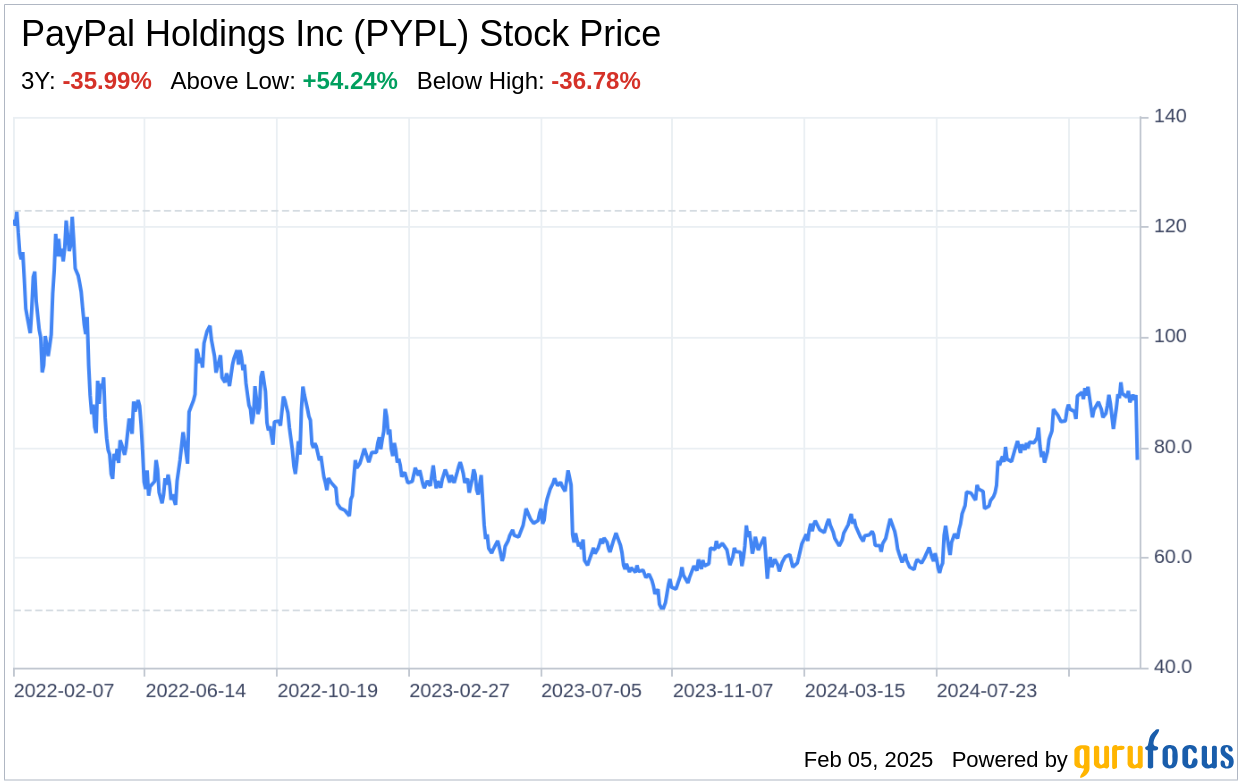On February 4, 2025, PayPal Holdings Inc (PYPL, Financial) filed its annual 10-K report, revealing a year of growth and strategic positioning in the dynamic electronic payment solutions sector. With a 10% increase in total payment volume (TPV) to $1.68 trillion and a 2% rise in active accounts to 434 million, PayPal demonstrates its ability to expand its transactional footprint and user engagement. The company's investment in research and development, amounting to $1.5 billion in 2024, underscores its dedication to innovation and maintaining a competitive edge. As we delve into a SWOT analysis of PayPal, these financial highlights provide a backdrop for understanding the company's strengths, weaknesses, opportunities, and threats in the context of an evolving digital payments landscape.

Strengths
Brand Recognition and Trust: PayPal's brand equity is a significant asset, with trusted names like PayPal, Venmo, and Braintree under its umbrella. The company's marketing efforts have successfully fostered brand visibility and customer preference, which are critical in the payments industry where trust is paramount. This brand strength is not only a testament to PayPal's past marketing successes but also a foundation for future growth as it continues to expand its global presence.
Two-Sided Platform and Scale: PayPal's two-sided platform connects millions of consumers and merchants, providing a seamless transaction experience. The scale of its operations, with 434 million active accounts, allows PayPal to leverage network effects, where each additional user adds value to the network as a whole. This scale also provides PayPal with a wealth of data, which can be used to innovate and personalize the user experience, further solidifying its market position.
Technological Agility: PayPal's technology-agnostic approach allows for flexibility in payment processing solutions and business financing products. This open ecosystem enables PayPal to integrate with various platforms and offer a wide range of payment methods, making it an attractive partner for merchants and consumers alike. The company's investment in technology infrastructure ensures that it can continue to innovate and meet the demands of a rapidly changing digital payments landscape.
Weaknesses
Regulatory Challenges: As a global entity, PayPal faces a complex web of regulations that vary by jurisdiction. These regulations can impact the company's operations and necessitate continuous monitoring and adaptation. The evolving regulatory landscape, particularly concerning privacy, cybersecurity, and financial services, poses a constant challenge for PayPal to remain compliant while also trying to innovate and expand its services.
Intense Competition: The payments industry is highly competitive, with traditional financial institutions and emerging fintech companies vying for market share. PayPal must continually differentiate itself through innovation and customer service to maintain its competitive edge. The company's ability to keep up with the pace of change and consumer expectations is crucial to its ongoing success.
Opportunities
Expansion of Digital Payments: The global shift from cash and checks to digital payments presents a significant opportunity for PayPal. By focusing on user experience and expanding its branded checkout business, PayPal can capitalize on the growing adoption of digital payment methods. The company's strategy to drive growth through increased monthly active accounts and payment transactions aligns with this trend and could lead to higher revenues.
Strategic Partnerships: PayPal's approach to building and deepening strategic partnerships can open new markets and enhance customer experiences. These collaborations can lead to customer acquisition and reinforce PayPal's role in the payments ecosystem. By leveraging these partnerships, PayPal can expand its reach and offer more comprehensive services to its users.
Threats
Cybersecurity Risks: As a digital payments platform, PayPal is inherently at risk of cyberattacks and data breaches. These security threats can damage the company's reputation and lead to financial losses. PayPal's commitment to cybersecurity is critical, but the ever-evolving nature of cyber threats means that the company must continuously invest in and update its security measures to protect customer data and maintain trust.
Macroeconomic Factors: PayPal's performance is influenced by the broader macroeconomic environment, including consumer spending patterns and economic growth. Any downturn in the global economy could negatively affect the volume of transactions processed through PayPal's platform, impacting its revenue and growth prospects.
In conclusion, PayPal Holdings Inc (PYPL, Financial) stands as a formidable player in the digital payments industry, bolstered by its strong brand, extensive user base, and technological prowess. However, the company must navigate regulatory complexities and intense competition while capitalizing on the shift towards digital payments and strategic partnerships. Cybersecurity remains a significant threat in an industry where consumer trust is critical. PayPal's forward-looking strategies, including a focus on innovation and expanding its offline presence, will be vital in leveraging its strengths and opportunities to mitigate its weaknesses and threats.
This article, generated by GuruFocus, is designed to provide general insights and is not tailored financial advice. Our commentary is rooted in historical data and analyst projections, utilizing an impartial methodology, and is not intended to serve as specific investment guidance. It does not formulate a recommendation to purchase or divest any stock and does not consider individual investment objectives or financial circumstances. Our objective is to deliver long-term, fundamental data-driven analysis. Be aware that our analysis might not incorporate the most recent, price-sensitive company announcements or qualitative information. GuruFocus holds no position in the stocks mentioned herein.
